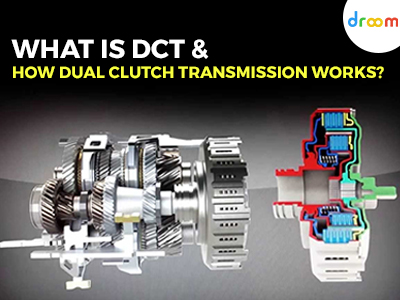One of the prime choices that comes before any car buyer is which transmission to go for. Selecting the suitable transmission can transform the entire car driving experience for you.
What is DCT (Dual clutch transmission)?
A dual clutch transmission or DCT is a hybrid of an automatic and manual transmission. The system is also known as twin clutch transmission and double clutch transmission. It is more similar to a manual transmission but uses two clutches for synchronizing the gear change. A DCT works using two clutches rather than one and they are computer-controlled and thus there is no need for a clutch pedal. A DCT functions through many in-built computers. The computer eliminates the requirement of change gears automatically and the complete process is automated. A DCT might be looked upon like an automatic transmission. The main difference between an automatic transmission and a DCT transmission is that a DCT does not use any torque converter.
How does DCT transmission work?
Though the benefits of automatic transmission compared to the manual is obvious but dual clutches are becoming increasingly popular through automatic systems are less complex and less expensive. A DCT uses two clutches that are controlled by a network of hydraulics and electronics so the driver does not need to use any clutch pedal.
Unlike an automatic transmission, the clutches in a DCT function independently. One controls the even gears while the other controls the odd-numbered gears. The setup enables the cars in shifting gears without interrupting the flow of power from an engine to the transmission that happens in the manual.
In a traditional manual transmission, there is no constant flow of power from the engine to the wheels. Rather power delivery changes during gearshift from on to off to on resulting in a phenomenon called torque to interrupt or shift shock.
What are dual clutch transmission advantages?
The basic objective behind a DCT is to minimize the gap between the gear shifts along with the benefits of fuel efficiency and improved performance. If you spent less time on the power during acceleration and by minimizing the time spent during gear changes, the fuel economy will be better and the engine power is not wasted.
The gear changes on a DCT can be measured in milliseconds and faster than a driver can, still retaining the benefits of a manual gearbox over an automatic. There are a lot of advantages to using dual-clutch transmission cars. It takes less than a second for a DCT to change gears. The improved acceleration makes DCT a popular choice. The superior speed and power offered by a DCT are becoming a great choice in new models and makes of car.
A DCT is great for performance driving. The computers make gears changing direct and fast. The smooth gear changes can eliminate many of the knocking or clunking sounds that are experienced with a manual transmission.
When you compare a DCT with any standard automatic transmission, you can experience 6% improved efficiency in acceleration and fuel. Transferring to automatic from manual is smooth and it allows the drivers to have more control over their driving. For people who prefer improved efficiency, power, fuel-saving, and flexibility, dual-clutch transmission bikes shall provide all these features. To sum up, the advantages are as follows:
- Faster acceleration than a normal manual clutch transmission as the time taken in changing the gear is negligible which is a matter of milliseconds.
- Shift shock is almost absent in this form of transmission, driving, and travelling become smooth sailing.
- As shifting gear is a matter of milliseconds, the shift of energy from the transmission to the engine is minimum which means less burning of fuel.
- The driver gets the freedom of choice whether to use the compare controlled shifting or manual paddle.
What are dual clutch transmission disadvantages?
There are disadvantages to a DCT mainly when such a transmission gets fitted into a family car. DCT can show a lucrative drivability character while motoring in parking lots at low speeds. They do not creep very smoothly like automatics. A dual-clutch car is not priced the same as an economy car. Manufacturers invest more money to produce these cars. If something goes wrong with a DCT, the repair and maintenance costs will be high.
The dual-clutch transmissions take the best features of manual and automatic and put them into a single-vehicle. If car buyers do not mind the higher cost, you can consider a DCT when you purchase your next vehicle.
